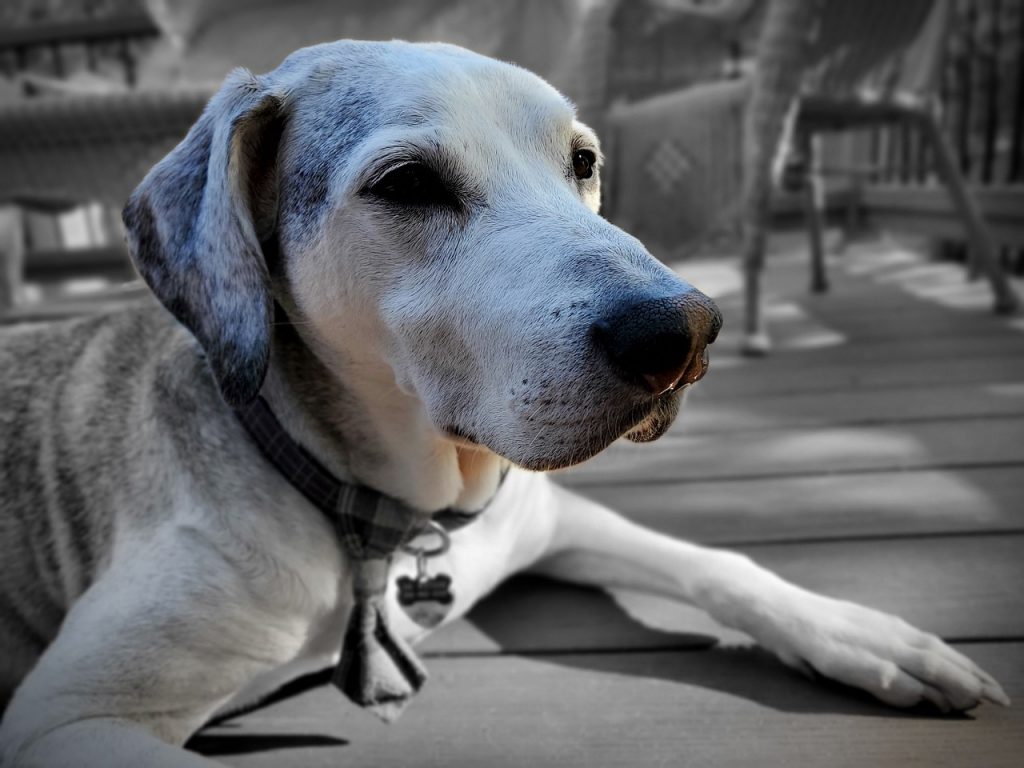In reality, both you and your dog will age. That sweet, dependable companion of yours will eventually show indications of mental and physical aging. The rate at which they age will change based on their breed and size.
Large dog breeds, such as the Great Dane, start getting old at around 6 years old. The average lifespan of a tiny dog, such as a Chihuahua, is 7-10 years. To ensure your dog’s continued good health as he ages, it’s important to recognize the first indications of aging as soon as possible.
5 signs that your dog is starting to age
1. Muzzle & plumage turn white (gray)
Age-related graying is inevitable, but you can’t predict when your dog will sport a silver mane.
Premature graying in dogs is a common problem, just as it is in people. That cute fluffy companion of yours might undergo a coat color shift at the tender age of three, or his thick dark brown fur might remain unchanged until he’s well into his teen years. The genetics of the dog’s parents typically dictate when the dog will begin turning gray. Based on when his parents started graying, it’s safe to assume he’ll start showing the same symptoms. It’s likely that an uncle will inherit his parents’ gray hair and snout coloration if the parents started going gray around the ages of seven or eight. When he was young, he would become gray the same way his parents had.

2. Hair loss and brittleness
As infants develop, they may experience gradual hair thinning. The hair on an older dog’s baby will grow back extremely slowly and there may be patches of hairlessness. Reduced cell activity manifests visually as gray hair and dry skin. Infant’s hair is finer, more delicate, and more easily damaged than adult hair.
A new coat will go on the baby soon. As a dog ages, his skin and coat will dry out and develop a scaly appearance. When feathers lose their luster, they no longer stand out. As dogs age, their skin typically becomes thicker and darker in tone. Their fur is dry and rough, so be prepared for that while touching one.
Changing to a more nourishing diet and giving your senior dog vitamins and minerals will do wonders for his or her skin and coat, not to mention the health of your pup. Your vet will probably advise you to feed your infant a diet low in grains and carbohydrates and high in protein. To help your baby’s digestive system absorb nutrients for improved skin and coat, try feeding them canned or wet food.

3. Loss/gain of weight
Your baby’s weight may fluctuate as she enters into new stages of development. Calories burned during exercise lead to fat storage in babies, but digestive issues or a lack of appetite have the opposite effect.
Food formulated for senior dogs typically includes less calories to aid with weight maintenance. No matter what you feed your baby, make sure to monitor each feeding to limit their calorie intake.
Weighing your kid frequently and adjusting his food intake is the only way to keep his weight in check. It’s a breeze for little canines, but if you have a big kid, it’s best to take them to the vet for some guidance.
4. Change behavior
Aging has a profound impact on a dog’s personality and behavior. It’s possible that your dog is less excited to meet you and is warier of new places on walks. It’s not uncommon for children with cognitive problems to exhibit signs of confusion or restlessness.
Although cognitive impairments and aging symptoms cannot be cured, there are treatments and remedies that can assist alleviate your baby’s discomfort. See your vet immediately if you observe any abnormal behavior, such as a lack of interest in playing or going outside, or prolonged looking at a wall.

5. Loss of perception
Your dog’s sense of smell, sight, and hearing may decline with age. When the underlying source of the sickness isn’t addressed, some dogs may even go blind or deaf.
Recognizing the early symptoms of a baby’s visual or hearing loss can be challenging. A newborn who cannot see or hear is more likely to be startled (or more angry) when someone approaches. There’s also a chance the infant won’t respond as well to its owner’s orders. Both of these symptoms are sometimes misinterpreted as “poor behavior,” leading the parent to chastise the child and increase the youngster’s stress levels.
Therefore, it’s important to make some adjustments to make things simpler for your senior dog. Be sure your baby’s feeding and watering stations, as well as his or her crib, are always in the same place. Even if you need to stroke your infant quickly, don’t move around too quickly, as this could frighten your newborn.
There is some doubt as to whether or not the newborn is blind when you see that his or her eyes are hazy. This is typically nuclear sclerosis, which seldom causes visual impairment. The lens is a potential contributor to the more serious eye disorder known as “cloudy eyes.”
Preparation procedures to make the senior dog’s life easier
If you upgrade your dog’s bedding and pay closer attention to him on walks, you’ll be able to aid in his healthy aging. Many senior dogs suffer from osteoarthritis. When a dog is in pain, its natural reaction is to try to conceal the fact that it is hurting. However, as osteoarthritis progresses, you’ll notice your infant is less energetic, particularly upon awakening from a stroll.
Improve the elderly dog’s bed since the infant will be sleeping more
If you have an older dog, you should get it an orthopedic bed to assist reduce the pain and strain in its muscles caused by the weight of the baby while he or she sleeps.
Older dogs, as you might guess, have less energy and sleep more. They require more downtime, so don’t wake them up from their daytime nap.
Improve walking time because old dogs often limp
To help your senior dog adjust to the changes brought on by old age, you should modify his or her regular walking schedule. Because of the risk of injury and the acceleration of osteoarthritis, it is advised to limit your baby’s walking to short distances.
To assist their dog improve bone health and have a better quality of life, owners can supplement joint functional foods in addition to minimizing intense exercise and providing a nicer bed. Joints in senior dogs might benefit from glucosamine and chondroitin supplements.
Summary
There are a number of changes in behavior and health that can occur as a dog ages, making it essential that you provide extra attention to your senior friend. To ensure the senior dog’s healthy and happy old life, you may take steps to enhance his living conditions and obtain advice on appropriate supplements from your veterinarian. If you start caring for your elderly child while he is young, he will live a longer and happier life. That’s why it’s important to keep an eye out for the aforementioned warning indicators.